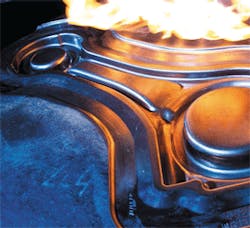In the simplest terms, heat and force are essential to producing high-quality forged products; they also punish die materials. Knowing what the punishment is, it is difficult for forgers to identify the best die material for a forging process, and for metallurgists and engineers to develop those materials, and for forging operators to maintain them.
In the cause of quality forgings, forging dies and tooling endure mechanical and thermal loads that lead to hot wear, cracks, plastic deformation, mechanical loads, and temperature variations that subject them to wear and fatigue. It’s not a surprise, then, that at least two projects listed by FIA and FIERF in their most recent “Forging Industry Technology Plan” address problems with forging die materials (“Effect of Surface Roughness of Hot Forging Die Surfaces,” “Mechanical Properties of Hot Forging Die Steels at Working Temperatures”). And, the FIA’s Closed Die Industry Collaborative Work Group has a project studying die-life improvement, too
In one sense, die life problems are accepted as a cost of doing business, but improving the performance and reducing the cost of die materials is an individual effort (one operation at a time), as well as a coordinated one. Better lubrication formulas and techniques are one route to such improvements, but it’s been noted generally that the need for lubrication is itself a reflection on the shortcomings of die materials. Material-surface coatings are another detail of the die-performance equation, and a variety of coatings have been developed to help reduce the effects of friction and heat on the die surface.
Simulation and geometric process modeling have helped to advance the understanding of forming processes, and from that has come new insights for die design. In turn, this is a boost to the materials science that is focused on die design, too. Improvements in computer modeling are drawing together the concerns of product designers, forging operations, material engineers, and die designers, who then have an opening to coordinate their process and design objectives.
But, as a practical matter, getting better performances from forging dies and die materials starts with product selection. More information, and more open communications with forging die and die material suppliers (see sidebar) will bring the most immediate benefits to forgers seeking better results.
Studies of forging die failures confirm that they are overwhelmingly the result of abrasive wear, as well as mechanical fatigue and thermal fatigue, and other familiar factors. So, the qualities to look for in the selection of optimal materials should begin by addressing the most essential need, and for this a forging operator should determine what are the prevailing causes of failure at his or her location. The performance of past and current die materials should be documented, and its particular qualities and statistical profile should be available for comparison. Production factors that may affect tooling performance should be noted, too.
An effective forging die steel should be one developed for that purpose, with necessary hardness and an ability to retain that hardness under operating conditions. Hot tensile strength and ductility across a range of temperatures are other qualities that must be present. Likewise, hardenability and resistance wear and fatigue are critical attributes of a quality forging die material.
Suppliers of forging die materials invest considerable time and resources in the effort, incorporating the results of their own research as well as industrial experience, and targeting performance objectives set by customers. They offer specific products for specific needs. A. Finkl & Sons, for example, articulates different profiles for different types of forging processes, and recommends different die materials accordingly.
“The two essential properties that characterize die steel are hardness, for wear resistance, and f racture toughness, required for crack resistance,” Finkl outlines in its précis for hammer dies. “Both of these characteristics change with alloy composit ion and heat-treated condition of the die steel. In general, die steel compositions that focus on wear resistance by having high carbon and alloy together with a high hardness, are susceptible to cracking. Alternatively, die steel compositions with lower carbon and alloy, and heat treated to a softer, more ductile condition will favor crack resistance over wear characteristics.”
Finkl takes a similarly categorical approach to die materials for mechanical and hydraulic presses, and other suppliers, too, can relate their product offerings to specific performance standards. The forger’s task is to understand what’s likely to happen, what improvements are possible, and what progress might be made toward improving die performance and enhancing the value of die materials in their production process.
| Die Materials, Die Design A. Finkl & Sons |
